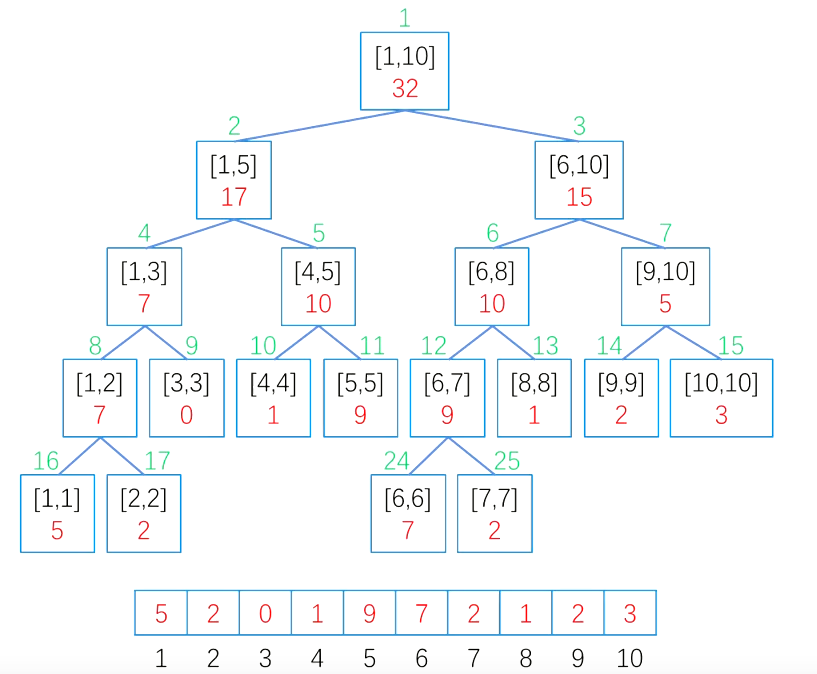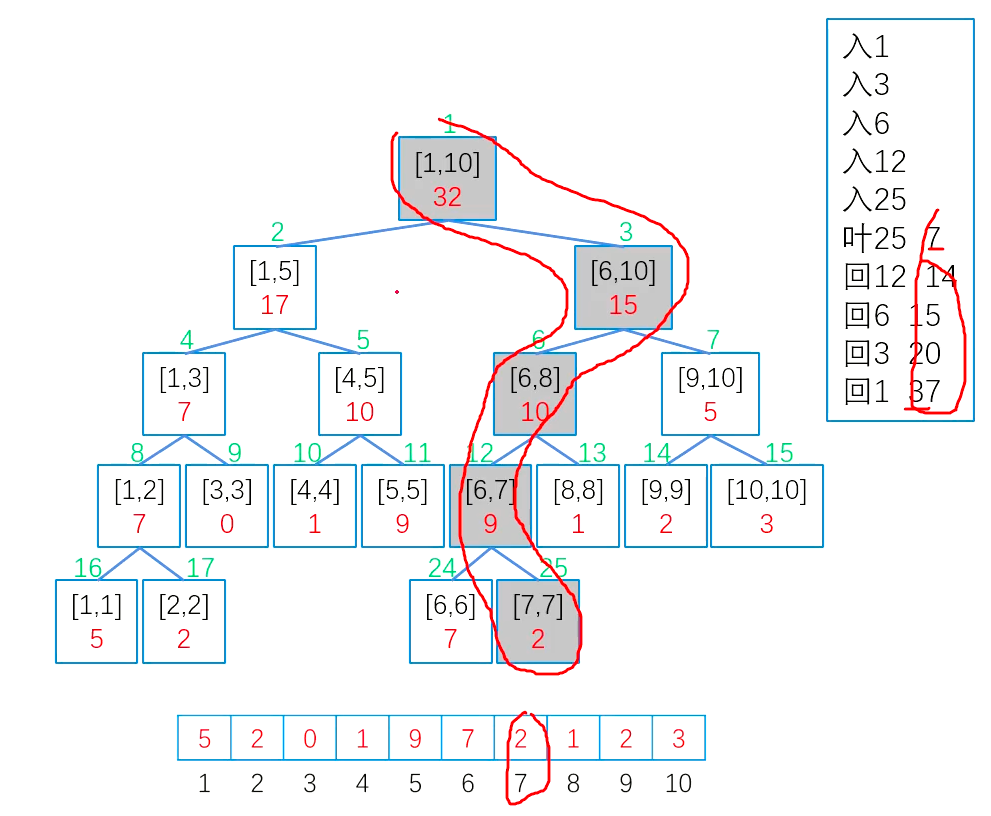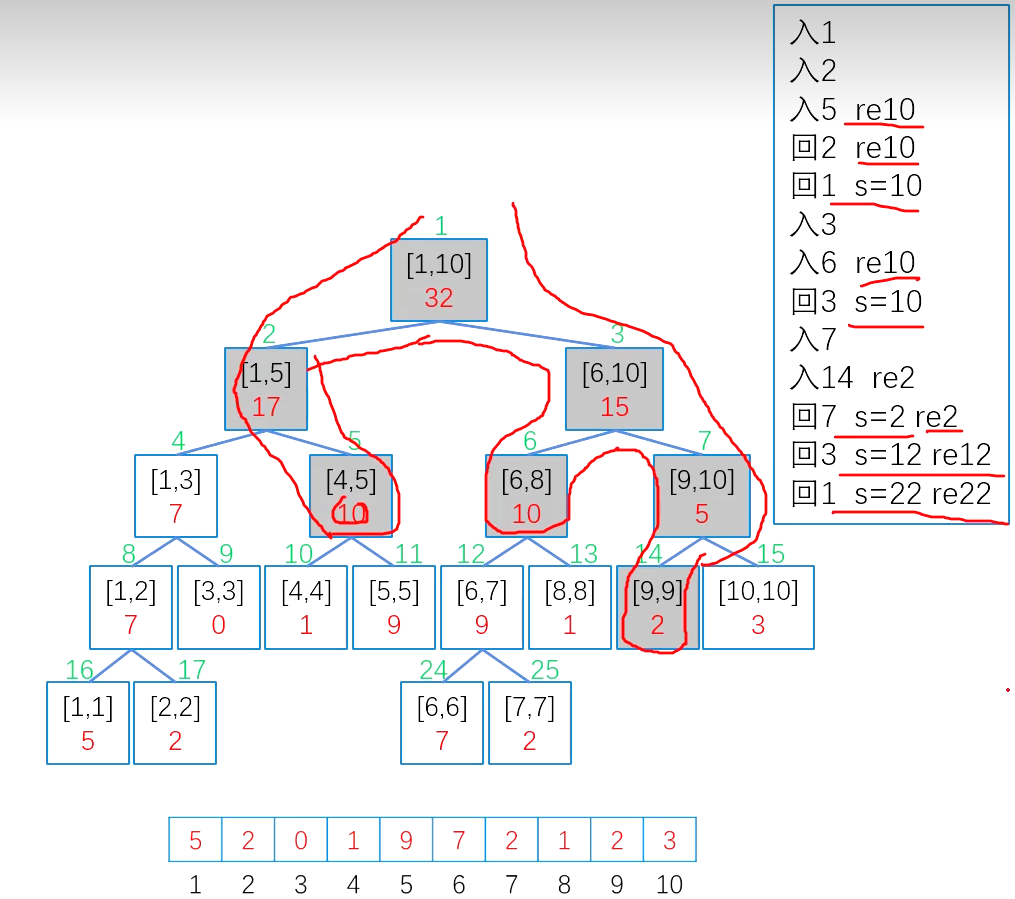线段树
线段树
线段树树基于分治思想的二叉树,用来维护区间信息(区间和、区间最大值、区间最小值等等)。可以在的时间内完成区间信息的查询和修改。
- 线段树中每个叶子结点存储元素本身,非叶子结点存储区间内元素的统计值

节点数组tr[]
l,r存区间的左右端点,sum存区间和
int n,w[N];
struct node{
int l,r,sum;
}tr[N*4];//注意需要开四倍空间
递归建树
父节点的编号为p
左孩子编号为2*p,右孩子编号为2*p+1
#define lc p<<1
#define rc p<<1|1 或者2*p+1
void build(int p,int l,int r){
tr[p]={l,r,w[l]};
if(l==r) return;//是叶子结点了,直接返回
int mid=l+r>>1;
build(lc,l,mid);
build(rc,mid+1,r);
tr[p].sum=tr[lc].sum+tr[rc].sum;
}
单点修改
从根节点进入,递归找到叶子结点[x,x],把该结点的值增加k,然后从下往上更新其祖先节点上的统计值。
void update(int p,int x,int k){//将x位置上的数加k
if(tr[p].l==x && tr[p].r==x){
tr[p].sum+=k;
return;
}
int mid=l+r>>1;
if(x<=mid) update(lc,x,k); //只会进入一个分支
else update(rc,x,k);
tr[p].sum=tr[lc].sum+tr[rc].sum;
}

区间查询
区间查询使用拆分和拼凑的思想,例如,查询区间
[4,9]可以拆分为[4,5],[6,8],[9,9],通过合并这三个区间的答案来求查询的答案。
从根节点进入,递归执行以下过程:
- 若查询区间[x,y]完全覆盖当前区间,则立即回溯,并返回该结点的sum值
- 若左子节点与[x,y]有重叠,则递归访问左子树
- 若右子节点与[x,y]有重叠,则递归访问右子树
int query(int p,int x,int y){
if(x<=tr[p].l &&tr[p].r<=y)return tr[p].sum;
int mid=tr[p].l+tr[p].r>>1;
int sum=0;
if(x<=mid) sum+=query(lc,x,y);
if(y>mid) sum+=query(rc,x,y);
return sum;
}

区间修改
例如对区间[4,5]内的每个数加上5,如果修改区间[x,y]所覆盖的每个叶子结点,时间是的
可以做懒惰修改,当[x,y]完全覆盖节点区间[a,b]时,先修改区间的sum值,然后打上一个懒标记,然后立即返回,等下次需要的时候,再下传懒标记,这样可以把修改和查询的时间都控制在内
void pushup(int p){
tr[p].sum=tr[lc].sum+tr[rc].sum;
}
void pushdown(int p){
if(tr[p].add){
tr[lc].sum+=tr[p].add* (tr[lc].r-tr[lc].l+1);
tr[rc].sum+=tr[p].add* (tr[rc].r-tr[rc].l+1);
tr[lc].add+=tr[p].add;
tr[rc].add+=tr[p].add;
tr[p].add=0;
}
}
void update(int p,int x,int y,int k){
if(x<=tr[p].l &&tr[p].r<=y){
tr[p].sum+=(tr[p].r-tr[p].l+1)*k;
tr[p].add+=k;
return;
}
int m=tr[p].l+tr[p].r>>1;
pushdown(p);
if(x<=m) update(lc,x,y,k);
if(y>m) update(rc,x,y,k);
pushup(p);
}
【模板】树状数组 1
链接:https://www.luogu.com.cn/problem/P3374
题目描述
如题,已知一个数列,你需要进行下面两种操作:
将某一个数加上
求出某区间每一个数的和
输入格式
第一行包含两个正整数 ,分别表示该数列数字的个数和操作的总个数。
第二行包含 个用空格分隔的整数,其中第 个数字表示数列第 项的初始值。
接下来 行每行包含 个整数,表示一个操作,具体如下:
1 x k含义:将第 个数加上2 x y含义:输出区间 内每个数的和
输出格式
输出包含若干行整数,即为所有操作 的结果。
样例 #1
样例输入 #1
5 5
1 5 4 2 3
1 1 3
2 2 5
1 3 -1
1 4 2
2 1 4
样例输出 #1
14
16
提示
【数据范围】
对于 的数据,,;
对于 的数据,;
对于 的数据,。
代码
#include <bits/stdc++.h>
#define int long long
#define yes cout << "YES" << endl;
#define no cout << "NO" << endl;
#define debug(s, x) cout << "#debug:(" << s << ")=" << x << endl;
using namespace std;
#define lc p << 1
#define rc p << 1 | 1
const int N = 5e5 + 10;
struct tr {
int l, r, sum;
} tr[N * 4];
int w[N];
void build(int p, int l, int r) {
tr[p] = {l, r, w[l]};
if (l == r)
return;
int mid = (l + r) >> 1;
build(lc, l, mid);
build(rc, mid + 1, r);
tr[p].sum = tr[lc].sum + tr[rc].sum;
}
void update(int p, int x, int k) {
if (tr[p].l == x && tr[p].r == x) {
tr[p].sum += k;
return;
}
int mid = (tr[p].l + tr[p].r) >> 1;
if (x <= mid)
update(lc, x, k);
else
update(rc, x, k);
tr[p].sum = tr[lc].sum + tr[rc].sum;
}
int query(int p, int x, int y) {
if (x <= tr[p].l && tr[p].r <= y) {
return tr[p].sum;
}
int mid = (tr[p].l + tr[p].r) >> 1;
int sum = 0;
if (x <= mid)
sum += query(lc, x, y);
if (y > mid)
sum += query(rc, x, y);
return sum;
}
void solve() {
int n, m;
cin >> n >> m;
for (int i = 1; i <= n; i++)
cin >> w[i];
build(1, 1, n);
while (m--) {
int a, b, c;
cin >> a >> b >> c;
if (a == 1)
update(1, b, c);
else
cout << query(1, b, c) << endl;
}
}
signed main() {
int _=1;
while (_--)
solve();
return 0;
}
【模板】线段树 1
链接:https://www.luogu.com.cn/problem/P3372
题目描述
如题,已知一个数列,你需要进行下面两种操作:
- 将某区间每一个数加上 。
- 求出某区间每一个数的和。
输入格式
第一行包含两个整数 ,分别表示该数列数字的个数和操作的总个数。
第二行包含 个用空格分隔的整数,其中第 个数字表示数列第 项的初始值。
接下来 行每行包含 或 个整数,表示一个操作,具体如下:
1 x y k:将区间 内每个数加上 。2 x y:输出区间 内每个数的和。
输出格式
输出包含若干行整数,即为所有操作 2 的结果。
样例 #1
样例输入 #1
5 5
1 5 4 2 3
2 2 4
1 2 3 2
2 3 4
1 1 5 1
2 1 4
样例输出 #1
11
8
20
提示
对于 的数据:,。
对于 的数据:,。
对于 的数据:。
保证任意时刻数列中所有元素的绝对值之和 。
代码
#include <bits/stdc++.h>
#define int long long
#define yes cout << "YES" << endl;
#define no cout << "NO" << endl;
#define debug(s, x) cout << "#debug:(" << s << ")=" << x << endl;
using namespace std;
#define lc p * 2
#define rc p * 2 + 1
const int N = 1e5 + 10;
int n, m;
struct tr {
int l, r, sum, add;
} tr[N * 4];
int w[N];
void pushup(int p) {
tr[p].sum = tr[lc].sum + tr[rc].sum;
}
void pushdown(int p) {
if (tr[p].add) {
tr[lc].sum += tr[p].add * (tr[lc].r - tr[lc].l + 1);
tr[rc].sum += tr[p].add * (tr[rc].r - tr[rc].l + 1);
tr[lc].add += tr[p].add;
tr[rc].add += tr[p].add;
tr[p].add = 0;
}
}
void build(int p, int l, int r) {
tr[p] = {l, r, w[l], 0};
if (l == r)
return;
int mid = (l + r) >> 1;
build(lc, l, mid);
build(rc, mid + 1, r);
pushup(p);
}
void update(int p, int x, int y, int k) {
if (x <= tr[p].l && tr[p].r <= y) {
tr[p].sum += (tr[p].r - tr[p].l + 1) * k;
tr[p].add += k;
return;
}
pushdown(p);
int mid = (tr[p].l + tr[p].r) >> 1;
if (x <= mid)
update(lc, x, y, k);
if (y > mid)
update(rc, x, y, k);
pushup(p);
}
int query(int p, int x, int y) {
if (x <= tr[p].l && tr[p].r <= y) {
return tr[p].sum;
}
pushdown(p);
int mid = (tr[p].l + tr[p].r) >> 1;
int res = 0;
if (x <= mid)
res += query(lc, x, y);
if (y > mid)
res += query(rc, x, y);
pushup(p);
return res;
}
void solve() {
cin >> n >> m;
for (int i = 1; i <= n; i++)
cin >> w[i];
build(1, 1, n);
while (m--) {
int op;
cin >> op;
if (op == 1) {
int x, y, k;
cin >> x >> y >> k;
update(1, x, y, k);
} else {
int x, y;
cin >> x >> y;
cout << query(1, x, y) << endl;
}
}
}
signed main() {
int _ = 1;
while (_--)
solve();
return 0;
}
最大数
链接:https://www.acwing.com/problem/content/1277/
给定一个正整数数列 ,每一个数都在 之间。
可以对这列数进行两种操作:
- 添加操作:向序列后添加一个数,序列长度变成 ;
- 询问操作:询问这个序列中最后 个数中最大的数是多少。
程序运行的最开始,整数序列为空。
一共要对整数序列进行 次操作。
写一个程序,读入操作的序列,并输出询问操作的答案。
输入格式
第一行有两个正整数 ,意义如题目描述;
接下来 行,每一行表示一个操作。
如果该行的内容是 Q L,则表示这个操作是询问序列中最后 个数的最大数是多少;
如果是 A t,则表示向序列后面加一个数,加入的数是 。其中, 是输入的参数, 是在这个添加操作之前最后一个询问操作的答案(如果之前没有询问操作,则 )。
第一个操作一定是添加操作。对于询问操作, 且不超过当前序列的长度。
输出格式
对于每一个询问操作,输出一行。该行只有一个数,即序列中最后 个数的最大数。
数据范围
,
,
输入样例:
10 100
A 97
Q 1
Q 1
A 17
Q 2
A 63
Q 1
Q 1
Q 3
A 99
输出样例:
97
97
97
60
60
97
样例解释
最后的序列是 。
思路
因为一开始序列的长度不知道是多少,但是最多m个询问,最坏情况下数组长度就为m呗,初始化的时候就可以建立1,m的线段树
然后使用线段树维护区间的最大值,使用n记录此时数组的长度,每次添加操作,n就加1
代码
#include <bits/stdc++.h>
#define int long long
#define yes cout << "YES" << endl;
#define no cout << "NO" << endl;
#define debug(s, x) cout << "#debug:(" << s << ")=" << x << endl;
using namespace std;
#define lc p << 1
#define rc p << 1 | 1
const int N = 2e5 + 10;
int n = 1, m, p, a;
struct node {
int l, r, sum;
} tr[N * 4];
void pushdown(int p) {
tr[p].sum = max(tr[lc].sum, tr[rc].sum);
}
void build(int p, int l, int r) {
tr[p] = {l, r, 0};
if (l == r)
return;
int mid = (l + r) >> 1;
build(lc, l, mid);
build(rc, mid + 1, r);
}
void update(int p, int x, int k) {
if (tr[p].l == x && tr[p].r == x) {
tr[p].sum = k;
return;
}
int mid = (tr[p].l + tr[p].r) >> 1;
if (x <= mid)
update(lc, x, k);
else
update(rc, x, k);
pushdown(p);
}
int query(int p, int x, int y) {
if (x <= tr[p].l && tr[p].r <= y) {
return tr[p].sum;
}
int mid = (tr[p].l + tr[p].r) >> 1;
int res = 0;
if (x <= mid)
res = max(res, query(lc, x, y));
if (y > mid)
res = max(res, query(rc, x, y));
return res;
}
void solve() {
cin >> m >> p;
build(1, 1, m);
while (m--) {
char op;
int x;
cin >> op >> x;
if (op == 'A') {
update(1, n, (a + x) % p);
n++;
} else {
a = query(1, n - x, n - 1);
cout << a << endl;
}
}
}
signed main() {
int _ = 1;
while (_--)
solve();
return 0;
}
你能回答这些问题吗
链接:https://www.acwing.com/problem/content/description/246/
给定长度为 的数列 ,以及 条指令,每条指令可能是以下两种之一:
1 x y,查询区间 中的最大连续子段和,即 {}。2 x y,把 改成 。
对于每个查询指令,输出一个整数表示答案。
输入格式
第一行两个整数 。
第二行 个整数 。
接下来 行每行 个整数 , 表示查询(此时如果 ,请交换 ), 表示修改。
输出格式
对于每个查询指令输出一个整数表示答案。
每个答案占一行。
数据范围
,
输入样例:
5 3
1 2 -3 4 5
1 2 3
2 2 -1
1 3 2
输出样例:
2
-1
思路
用线段树维护区间最大的连续子段和:
- 记录区间的和
- 记录区间的从开始的最大连续子段和
- 记录区间的从开始的最大连续子段和
- 记录区间的最大连续子段和
在更新父节点的这些数据时,有:
父节点的区间和就是两个子节点的区间和之和
父节点从左开始的最大连续子段和为 max(左儿子从左开始的最大连续字段和,左孩子的区间和+右儿子从左开始的最大连续子段和)
父节点的区间最大连续字段和为 左儿子的右连续区间和+右儿子的左连续区间和 以及左右儿子各自最大连续区间和取最大值。
代码
#include <bits/stdc++.h>
#define int long long
#define yes cout << "YES" << endl;
#define no cout << "NO" << endl;
#define debug(s, x) cout << "#debug:(" << s << ")=" << x << endl;
using namespace std;
#define lc p << 1
#define rc p << 1 | 1
const int N = 5e5 + 10;
int n, m;
int w[N];
struct node {
int l, r, sum, lmax, rmax, max;
} tr[N * 4];
void pushdown(int p) {
tr[p].sum = tr[lc].sum + tr[rc].sum;
tr[p].lmax = max(tr[lc].lmax, tr[lc].sum + tr[rc].lmax);
tr[p].rmax = max(tr[rc].rmax, tr[rc].sum + tr[lc].rmax);
tr[p].max = max(max(tr[lc].max, tr[rc].max), tr[lc].rmax + tr[rc].lmax);
}
void build(int p, int l, int r) {
tr[p] = {l, r, w[l], w[l], w[l], w[l]};
if (l == r)
return;
int mid = (l + r) >> 1;
build(lc, l, mid);
build(rc, mid + 1, r);
pushdown(p);
}
void update(int p, int x, int k) {
if (tr[p].l == x && tr[p].r == x) {
tr[p] = {x, x, k, k, k, k};
return;
}
int mid = (tr[p].l + tr[p].r) >> 1;
if (x <= mid)
update(lc, x, k);
else
update(rc, x, k);
pushdown(p);
}
node query(int p, int x, int y) {
if (x <= tr[p].l && tr[p].r <= y) {
return tr[p];
}
int mid = (tr[p].l + tr[p].r) >> 1;
if (y <= mid)
return query(lc, x, y);
if (x > mid)
return query(rc, x, y);
node left = query(lc, x, y);
node right = query(rc, x, y);
node t;
t.sum = left.sum + right.sum;
t.lmax = max(left.lmax, left.sum + right.lmax);
t.rmax = max(right.rmax, right.sum + left.rmax);
t.max = max(max(left.max, right.max), right.lmax + left.rmax);
return t;
}
void solve() {
cin >> n >> m;
for (int i = 1; i <= n; i++)
cin >> w[i];
build(1, 1, n);
int op, x, y;
while (m--) {
cin >> op >> x >> y;
if (op == 1) {
if (x > y)
swap(x, y);
cout << query(1, x, y).max << endl;
} else
update(1, x, y);
}
}
signed main() {
int _ = 1;
while (_--)
solve();
return 0;
}
